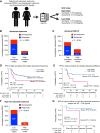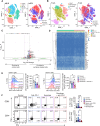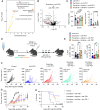Sucralose Consumption Ablates Cancer Immunotherapy Response through Microbiome Disruption
- PMID: 40742298
- PMCID: PMC12580791
- DOI: 10.1158/2159-8290.CD-25-0247
Sucralose Consumption Ablates Cancer Immunotherapy Response through Microbiome Disruption
Abstract
Gut microbiota composition is directly associated with response to immunotherapies in cancer. The impact of diet on the gut microbiota and downstream immune responses to cancer remains unclear. In this study, we show that consumption of a common nonnutritive sweetener, sucralose, modifies microbiome composition, restricts T-cell metabolism and function, and limits immunotherapy response in preclinical models of cancer and patients with advanced cancer treated with anti-PD-1-based immune checkpoint inhibitors. Sucralose consumption is associated with a reduction in microbiota-accessible arginine, and amino acid supplementation or fecal microbiome transfer from anti-PD-1 responder mice completely restores T-cell function and immunotherapy response. Overall, sucralose consumption destabilizes the gut microbiota, resulting in compromised T-cell function and ablated immune checkpoint inhibitor response in cancer.
Significance: This study highlights an unappreciated role of sucralose in reducing immunotherapy efficacy in both mouse models and samples from patients with cancer through shifts in the microbiome and arginine degradation that lead to T-cell exhaustion. T-cell function and immunotherapy responses are restored through amino acid supplementation. See related commentary by Chandra et al., p. 2196.
©2025 The Authors; Published by the American Association for Cancer Research.
Conflict of interest statement
Z.L. Dahmani reports grants from NIH during the conduct of the study. L.P. Kane reports grants from NIH during the conduct of the study. G.M. Delgoffe reports grants and personal fees from Novasenta and RemplirBio outside the submitted work. D. Davar reports other support from Immunocore, Replimmune, Castle Biosciences, Regeneron, mBiomics, and Zola, personal fees from ACM Bio, Ascendis, Castle, Clinical Care Options, Gerson Lehrman Group, Immunitas, Medical Learning Group, Replimmune, Trisalus, and Xilio Therapeutics, and grants from Arcus, Immunocore, Merck, Regeneron, and Tesaro/GSK,\ outside the submitted work, as well as Intellectual Property: US Patent 63/124,231, “Compositions and Methods for Treating Cancer”, December 11, 2020 and US Patent 63/208,719, “Compositions and Methods For Responsiveness to Immune Checkpoint Inhibitors (ICI), Increasing Effectiveness of ICI and Treating Cancer”, June 9, 2021. No disclosures were reported by the other authors.
Figures







References
MeSH terms
Substances
Grants and funding
- P30CA047904/National Institutes of Health (NIH)
- G-22-800/Gateway Foundation (Gateway)
- Dale F. Frey Breakthrough Scientist Award/Damon Runyon Cancer Research Foundation (DRCRF)
- P50 CA254865/CA/NCI NIH HHS/United States
- DP2 AI177967/AI/NIAID NIH HHS/United States
- T32GM008208/National Institutes of Health (NIH)
- P30 CA047904/CA/NCI NIH HHS/United States
- S10OD032141/National Institutes of Health (NIH)
- T32 GM008208/GM/NIGMS NIH HHS/United States
- S10OD023402/National Institutes of Health (NIH)
- U01 CA268806/CA/NCI NIH HHS/United States
- U01 CA271407/CA/NCI NIH HHS/United States
- R01 AI138504/AI/NIAID NIH HHS/United States
- R01 CA257265/CA/NCI NIH HHS/United States
- R01 CA206517/CA/NCI NIH HHS/United States
- DP2AI177967/National Institutes of Health (NIH)
- R01CA206517/National Institutes of Health (NIH)
- S10 OD032141/OD/NIH HHS/United States
- S10 OD023402/OD/NIH HHS/United States
LinkOut - more resources
Full Text Sources
Medical
Molecular Biology Databases

